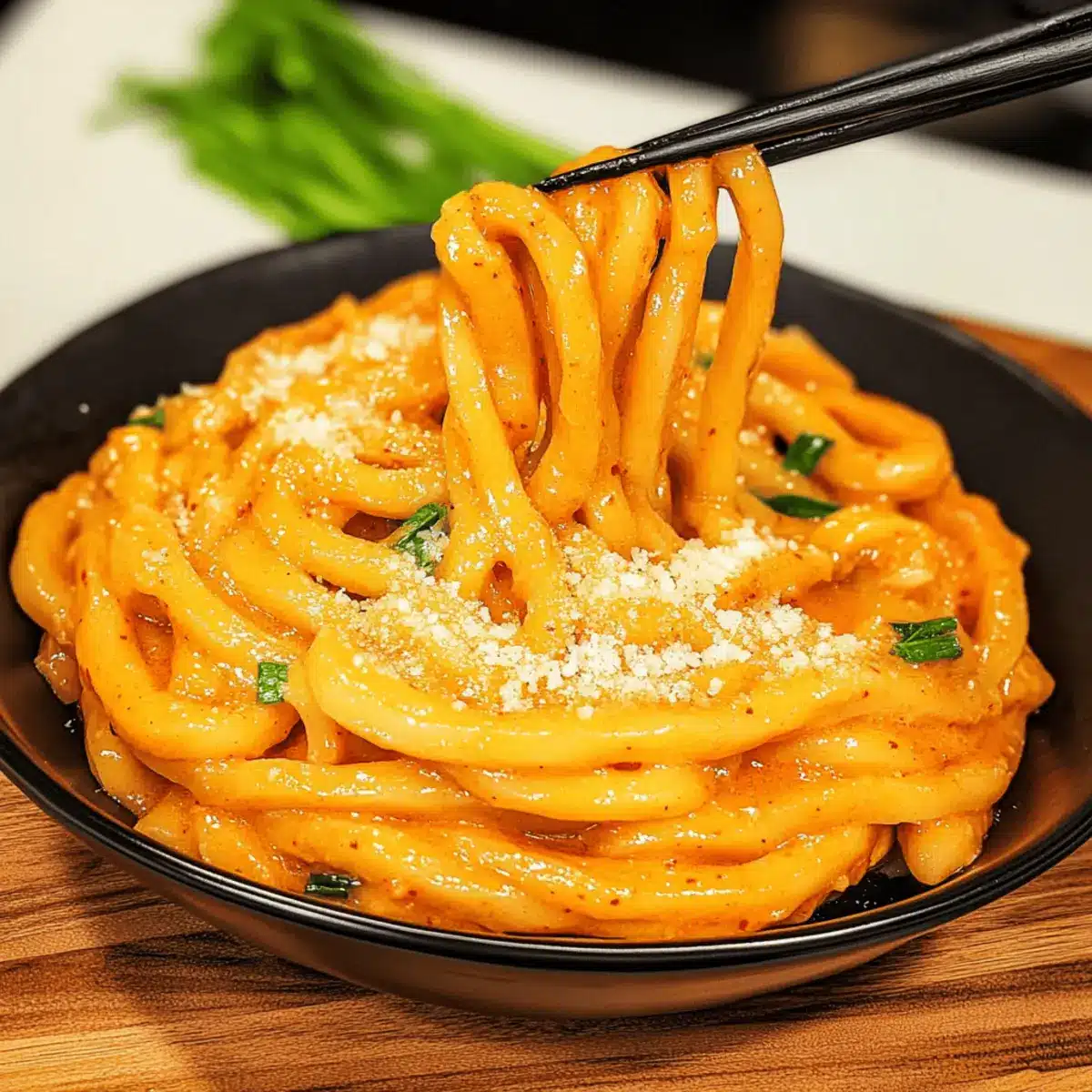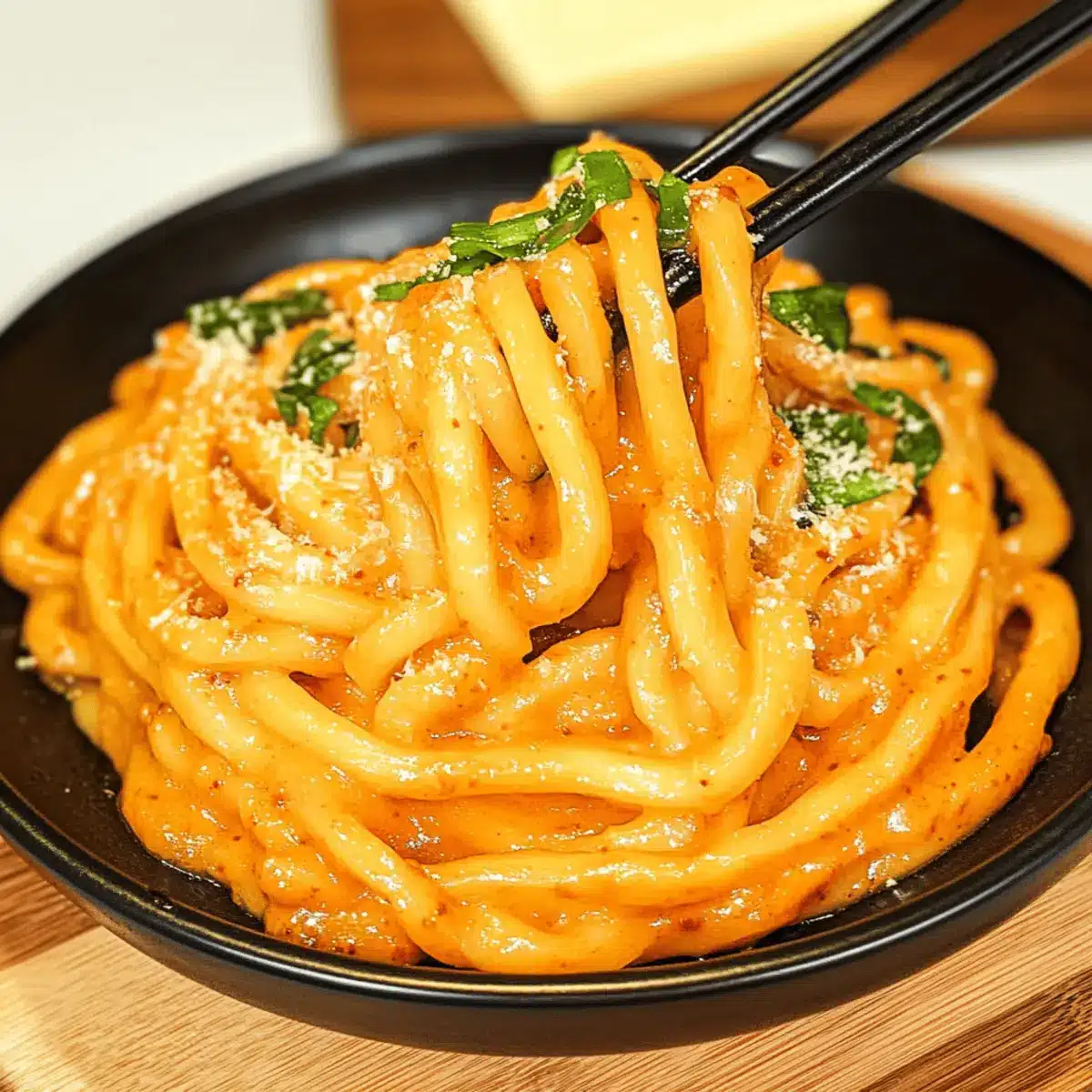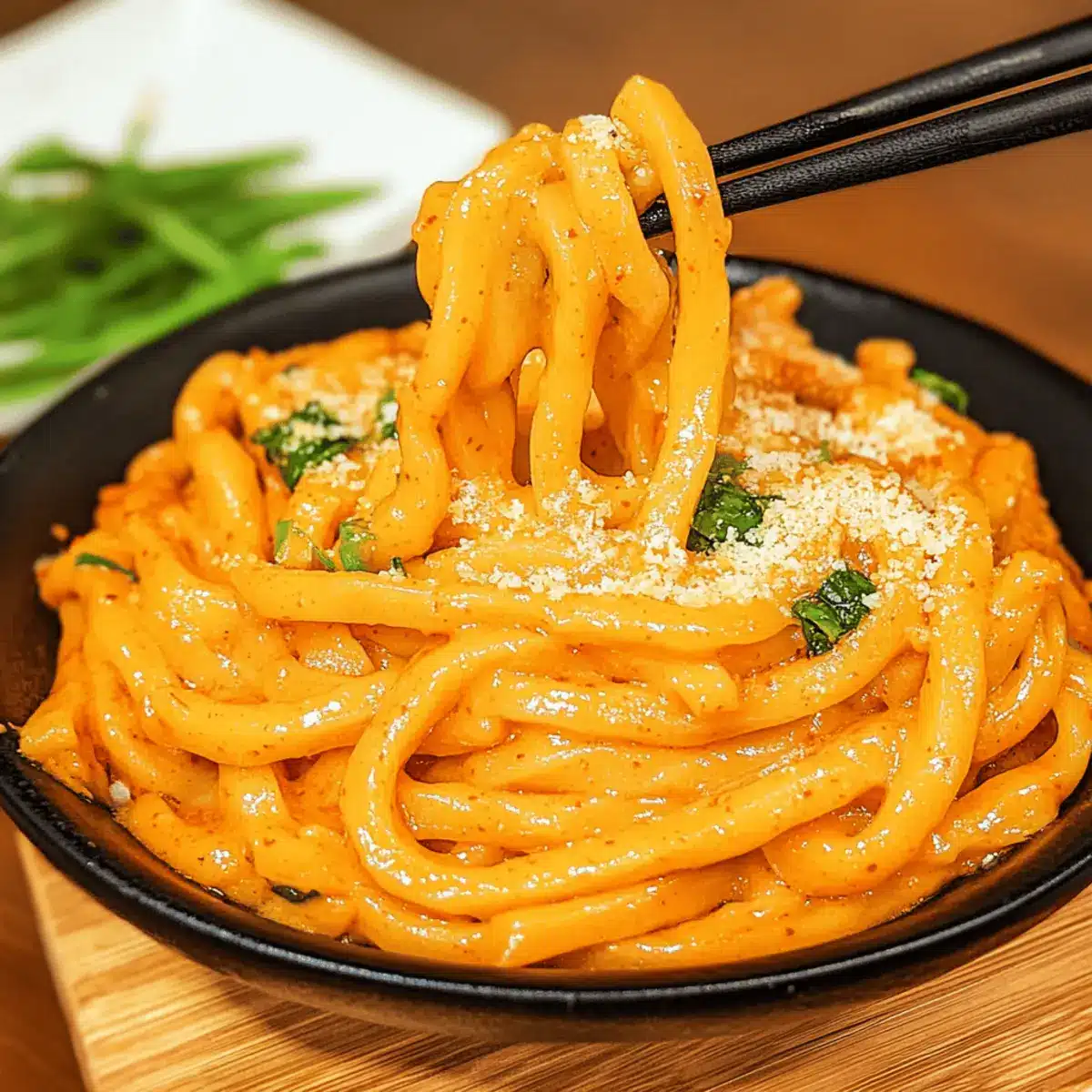The air was filled with an enticing blend of spices as I stirred together my latest dinner creation: Creamy Gochujang Udon Noodles. In just 20 minutes, this bowl of comfort transforms simple ingredients into a lush, velvety sauce that’s perfect for those evenings when you crave something bold yet easy. What I love most about these udon noodles is not only their rich and spicy warmth but also how quickly they come together—making them a foolproof choice for busy weeknights. Plus, as a vegetarian-friendly dish, it’s ideal for anyone looking to skip the takeout and whip up something homemade. Curious about how this delightful fusion of creamy and spicy flavors can elevate your dinner routine? Let’s dive in!

Why Are Creamy Gochujang Udon Noodles So Amazing?
Quick and Easy: Enjoy a restaurant-quality dish right at home, ready in just 20 minutes. Creaminess: The rich, buttery sauce envelops every noodle, creating a comforting embrace. Spicy Kick: Gochujang delivers a unique heat that invigorates your taste buds. Versatile: Customize with your favorite veggies or protein for a hearty meal. Vegetarian-Friendly: Perfect for those looking to skip meat without sacrificing flavor. These delicious noodles are simply irresistible, making dinner something to look forward to! For a delightful pairing, consider serving them alongside Garlic Chicken Noodles or Parmesan Chicken Pasta.
Creamy Gochujang Udon Noodles Ingredients
For the Noodles
• Frozen Udon Noodles – The star of the dish, these provide a delightful chewy texture; fresh udon can be used if available.
For the Sauce
• Butter – This adds a rich, creamy base to the sauce; substitute with vegetable oil for a dairy-free version.
• Minced Garlic – Freshly minced garlic brings aromatic flavor, elevating the dish; powdered garlic can work in a pinch.
• Chopped Shallots – Adds sweetness and depth; yellow or white onion is a great alternative if shallots are hard to find.
• Gochujang – A must-have for that signature kick; this spicy Korean chili paste offers complexity that makes Creamy Gochujang Udon Noodles shine.
• Heavy Cream – Provides luxurious creaminess; coconut cream can be used for a non-dairy option.
• Soy Sauce – Offers umami, complementing the sauce; tamari is a good gluten-free substitute.
• Gochugaru – For additional heat and flavor; optional, but a sprinkle of cayenne can substitute nicely.
For Serving
• Grated Parmesan Cheese – Adds a finishing touch of creaminess; nutritional yeast serves as a vegan alternative.
• Chopped Green Onion – This garnishing addition brightens up the plate; fresh cilantro or parsley can also be delightful.
Feel free to gather these ingredients and get ready to create a dish that turns your weeknight meals into something extra special!
Step‑by‑Step Instructions for Creamy Gochujang Udon Noodles
Step 1: Cook Udon
Begin by boiling a large pot of water. Once it’s at a rolling boil, add frozen udon noodles and cook them according to package instructions, typically about 8-10 minutes. When they are tender yet chewy, reserve ½ cup of the cooking water before draining the noodles in a colander. Rinse the noodles under cold water to stop the cooking process and prevent sticking.
Step 2: Sauté Aromatics
In a spacious, non-stick skillet, melt 2 tablespoons of butter over medium heat. Once melted and bubbling, add 2 cloves of minced garlic and 1 diced shallot. Sauté for about 2 minutes until they become fragrant and translucent, stirring occasionally to avoid browning. This aromatic base will infuse your Creamy Gochujang Udon Noodles with delicious flavor.
Step 3: Make Sauce
Stir in 3 tablespoons of gochujang into the sautéed garlic and shallots. Allow the mixture to cook for about 30 seconds, stirring to combine thoroughly for a well-integrated flavor. Gradually pour in ½ cup of heavy cream and the reserved noodle water, mixing continuously. Add 1 tablespoon of soy sauce and, if desired, a pinch of gochugaru for extra heat, then let the sauce simmer for about 3-5 minutes until thickened.
Step 4: Combine
After the sauce has thickened, carefully add the cooked udon noodles to the skillet. Gently toss the noodles in the creamy gochujang sauce to ensure every piece is generously coated. If the sauce seems too thick, you can adjust it with a splash of reserved noodle water. This step is crucial for achieving that luscious texture your Creamy Gochujang Udon Noodles are known for.
Step 5: Serve
Once well combined, remove the skillet from the heat and plate the creamy udon noodles. Top each serving with freshly grated Parmesan cheese and a sprinkle of chopped green onion for freshness. For an extra touch, you may add a raw egg yolk on top, providing a beautiful richness. Serve immediately while hot and enjoy a comforting bowl of savory goodness!

How to Store and Freeze Creamy Gochujang Udon Noodles
Fridge: Store leftovers in an airtight container for up to 3 days. To reheat, gently warm in a skillet, adding a splash of water or cream to prevent drying out.
Freezer: For longer storage, freeze the creamy gochujang udon noodles in a sealed container for up to 2 months. Thaw overnight in the fridge before reheating.
Reheating: When ready to enjoy, reheat in a pan over low heat, stirring occasionally, and add a little reserved cooking water to loosen the sauce.
Room Temperature: It’s best to avoid leaving cooked noodles out for more than 2 hours to ensure food safety.
Creamy Gochujang Udon Noodles Variations
Embrace your culinary creativity as you explore delightful twists on this recipe that will tantalize your taste buds.
-
Veggie-Packed: Add bell peppers, spinach, or snap peas for an extra burst of color and nutrition.
-
Protein Boost: Toss in grilled chicken, succulent shrimp, or hearty tofu to make it a more filling meal. Each protein variation will bring its unique flavor, pairing beautifully with the creamy sauce.
-
Heat Level: Adjust the spiciness by adding extra gochugaru or serve with a side of sliced jalapeños for those who dare!
-
Gluten-Free: Swap out regular udon noodles for gluten-free rice noodles for a satisfying dish that everyone can enjoy.
-
Nutty Flavor: Drizzle sesame oil for a warm, nutty aroma that complements the gochujang perfectly.
-
Asian Fusion: Experiment with adding a splash of hoisin sauce for a sweet and savory kick that enhances the dish.
-
Creamy Vegan: Substitute heavy cream with coconut cream and omit cheese for a luscious vegan version that still delights the senses.
-
Alternative Sauces: Mix in peanut sauce or spicy sesame sauce for a twist that refreshes the flavor profile while keeping it creamy.
With these variations, you’ll never have a dull moment at dinner! For more delicious inspiration, consider trying out my Cajun Chicken Pasta or Flavorful Beef Udon.
What to Serve with Creamy Gochujang Udon Noodles
Elevate your dining experience by pairing these creamy, spicy noodles with delightful sides and sips that enhance every bite.
-
Garlic Edamame: Lightly salted and steamed, these tender soybeans add a protein-packed crunch and a touch of freshness to balance the noodles’ richness.
-
Asian Cucumber Salad: Crisp, cool, and dressed in sesame vinaigrette, this refreshing salad contrasts beautifully with the creamy gochujang sauce while cleansing the palate.
-
Crispy Spring Rolls: These golden-brown rolls filled with vegetables provide a satisfying crunch that complements the soft texture of the udon noodles.
-
Miso Soup: A warm bowl of miso soup brings umami richness, creating a comforting experience alongside the spicy creamy noodles. This classic pairing is both traditional and delightful.
-
Grilled Tequila Lime Chicken: Marinated and seared to juicy perfection, the citrus and spice of this dish harmonize with the bold flavors of the udon noodles.
-
Szechuan Stir-Fried Greens: Bright and vibrant greens sautéed in garlic and chili oil offer a spicy and nutritious accompaniment that complements the creamy noodles.
-
Chilled Green Tea: This lightly sweetened, refreshing beverage cools the palate while enhancing the spicy undertones of the dish.
-
Mango Sticky Rice: For dessert, this sweet and satisfying treat contrasts with the savory flavors of the noodles, providing a delightful finish to your meal.
Each pairing enhances the umami richness of the Creamy Gochujang Udon Noodles, transforming dinner into an exciting culinary adventure!
Expert Tips for Creamy Gochujang Udon Noodles
- Noodle Preparation: Rinse the cooked udon noodles in cold water to prevent them from sticking together, ensuring a perfectly creamy finish for your Creamy Gochujang Udon Noodles.
- Butter vs. Oil: While butter adds richness, using vegetable oil instead keeps the dish dairy-free. Choose based on your dietary needs!
- Taste Test: Before serving, always taste and adjust seasoning. Depending on your spice tolerance, feel free to add more gochugaru for that extra kick.
- Sauce Thickness: If the sauce is too thick, incorporate a splash of reserved noodle water gradually until you reach your desired consistency—this prevents clumping.
- Aromatic Timing: Sauté garlic and shallots just until fragrant; overcooking can cause bitterness, so keep an eye on them!
- Customizable Flavor: Feel free to mix in your favorite vegetables or proteins to enhance the dish. It’s equally delicious with bell peppers, tofu, or shrimp!
Make Ahead Options
These Creamy Gochujang Udon Noodles are ideal for meal prep, saving you precious time on busy weeknights! You can prepare the creamy gochujang sauce and sauté the garlic and shallots up to 3 days in advance. Just refrigerate the sauce in an airtight container to maintain its rich flavor. When you’re ready to serve, cook the udon noodles fresh according to the package instructions, then toss them in the prepared sauce over medium heat. Add a splash of reserved noodle water if the sauce thickens in the fridge. With this make-ahead strategy, you’ll enjoy a quick, delicious meal that’s just as satisfying!

Creamy Gochujang Udon Noodles Recipe FAQs
What type of udon noodles should I use?
I recommend using frozen udon noodles for this recipe as they provide that perfect chewy texture. If you prefer, fresh udon noodles can also be used; just make sure to adjust the cooking time according to the package instructions to ensure they’re cooked properly.
How do I store leftover Creamy Gochujang Udon Noodles?
Leftovers can be stored in an airtight container in the refrigerator for up to 3 days. To reheat, gently warm them in a skillet over low heat, stirring occasionally and adding a splash of water or cream to keep the sauce creamy and prevent it from drying out.
Can I freeze Creamy Gochujang Udon Noodles?
Absolutely! You can freeze the udon noodles in a sealed container for up to 2 months. For best results, thaw them overnight in the fridge before reheating. When ready, reheat on low heat in a pan, adding a little reserved noodle water to loosen the sauce if necessary.
What should I do if my sauce is too thick?
If you find the sauce has thickened too much, don’t worry! Just add a splash of reserved noodle water gradually while tossing the noodles in the sauce until you reach your desired consistency. This will help achieve that luscious texture you’re after.
Can I modify this recipe for dietary restrictions?
Certainly! This recipe is quite versatile. You can substitute butter with vegetable oil for a dairy-free version, and if you’re looking for a vegan option, use coconut cream instead of heavy cream and nutritional yeast in place of Parmesan cheese. Adjust the soy sauce to tamari for gluten-free needs, and feel free to add or omit vegetables and proteins according to your diet!
How do I know if my gochujang is still good?
Gochujang should maintain its flavor and aroma for quite some time. If you notice any unusual odors or mold, it’s best to discard it. For optimal freshness, store it in a cool, dry place and use it within 6 months after opening.

Creamy Gochujang Udon Noodles for Quick Spicy Comfort
Ingredients
Equipment
Method
- Boil a large pot of water. Add frozen udon noodles and cook according to package instructions, about 8-10 minutes. Reserve ½ cup of cooking water before draining.
- Melt 2 tablespoons of butter in a skillet over medium heat. Add minced garlic and diced shallot, sauté for about 2 minutes until fragrant.
- Stir in 3 tablespoons of gochujang, cook for 30 seconds. Gradually add ½ cup of heavy cream and reserved noodle water. Mix in 1 tablespoon of soy sauce and optionally a pinch of gochugaru. Simmer for about 3-5 minutes until thickened.
- Add cooked udon noodles to the skillet and toss in the creamy sauce until well coated. Adjust thickness with reserved noodle water if needed.
- Plate the noodles, top with grated Parmesan cheese and chopped green onion. Serve immediately.

Leave a Reply